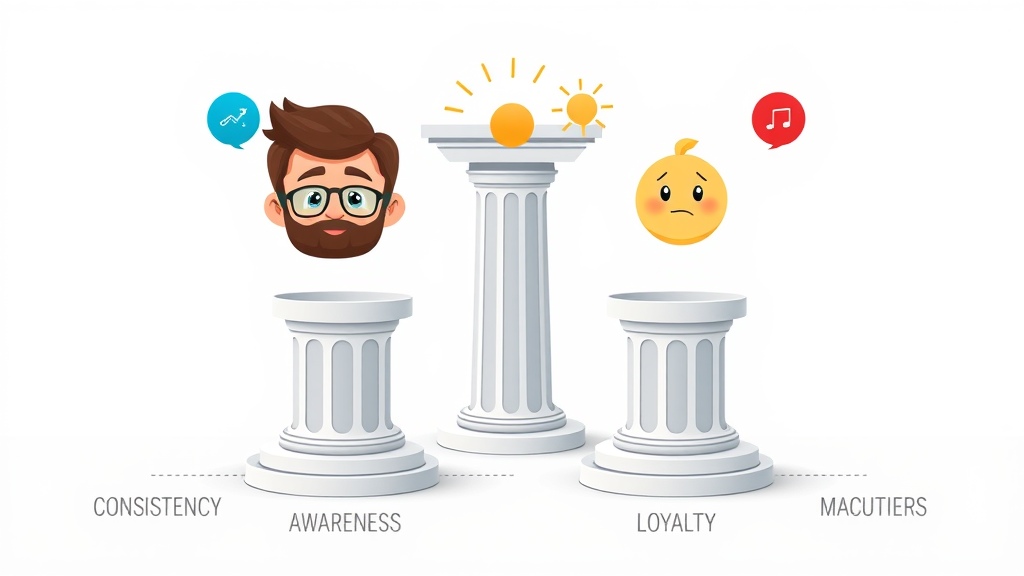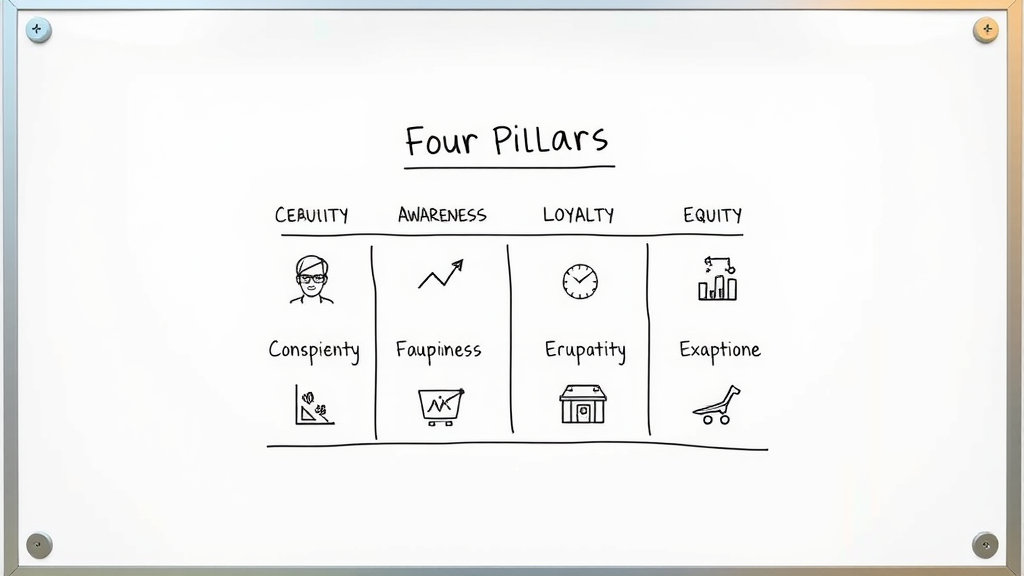Did you know that a staggering 80% of brand failures happen due to poor brand management and lack of strategic direction? If you’re feeling overwhelmed, you’re not alone—most businesses don’t realize how pivotal an effective brand management strategy is until brand equity, loyalty, or awareness begins slipping away. But here’s the good news: you can turn things around right now with proven methods that today’s most successful brands use every single day.
Startling Insights: The State of Brand Management Today
Brand management is in a state of continuous evolution, impacted by rapid shifts in digital marketing strategies, fierce industry competition, and ever-changing consumer expectations. Even seasoned brands can fall victim to stagnation if their brand management doesn't adapt. Consider this: with constantly evolving platforms and a globalized market, controlling your brand image, guiding your brand equity, and ensuring consistent messaging is more challenging—and more urgent—than ever.
Top companies who thrive do not leave brand asset management to chance. They invest in skilled brand managers, robust brand guides, and frameworks for measuring progress. What’s more, these leaders focus on building brand loyalty, shaping audience perceptions, and utilizing social media as powerful brand channels. If you want a strong brand, understanding contemporary brand management best practices is critical. This article will help you quickly grasp the landscape, identify what works, and learn how to start managing a brand like a pro.

"A staggering 80% of brand failures happen due to poor brand management and lack of strategic direction." – Brand Strategy Institute
What You'll Learn About Brand Management
- Essential components and steps in effective brand management
- The role of a brand manager and their influence
- Key pillars and frameworks for building a strong brand
- Popular tools, techniques, and strategies for maintaining brand equity
- How to align social media and brand asset management with your marketing plan
- Answers to the most common questions about brand management
Defining Brand Management: What Is It and Why Does It Matter?
At its core, brand management is the ongoing process of creating, maintaining, and improving everything that your audience associates with your business—your brand image, your voice, and even the emotions your products or services inspire. In today’s crowded markets, successful brand management is what sets top companies apart from the rest. It ensures your company’s brand values are clearly communicated, fostering emotional connections that lead to brand loyalty and repeat business.
For brands hoping to attract and retain a loyal customer base, the importance of a robust brand management program cannot be overstated. Poor brand management leads to inconsistent messaging, lost sales, and a fragmented customer base. Brands with strong brand equity are better positioned to weather competition, pivot with market trends, and expand their target audience. Simply put: if you want a recognizable brand with staying power, effective brand management should be your top priority.
As you work to define and strengthen your brand management approach, it’s helpful to explore actionable solutions tailored to common challenges. For a step-by-step breakdown and practical fixes, see this resource on overcoming brand management struggles—it offers tactical advice for immediate improvement.
What is meant by brand management?
Brand management refers to a holistic strategy that defines, positions, grows, and protects your brand identity in the minds of customers. This multifaceted process goes beyond simple marketing strategies; it involves monitoring every interaction that shapes public perception—from your visual identity to customer service, from social posts to how your products or services are delivered.
An effective brand management plan enables you to mold your reputation proactively, safeguard your brand assets (like logos and messaging), and make sure your message resonates with your target market. By keeping your brand guide up-to-date and leveraging brand assets consistently across every touchpoint, you not only build brand equity—you influence customer decisions at every stage. In essence, brand management gives you both the steering wheel and a map for the journey of your brand.

The 4 Pillars of Brand Management
A resilient brand stands firm on four foundational pillars: Consistency, Awareness, Loyalty, and Equity. Understanding and strengthening these pillars is at the heart of effective brand management. Organizations that focus on these elements consistently outpace competitors in building lasting brand equity and expanding their loyal customer base. These pillars also underpin every brand strategy decision, from positioning to brand asset protection and beyond.
Each pillar supports different facets of brand growth—whether it’s maintaining a unified image across all platforms (Consistency), driving market presence (Awareness), creating an emotional connection through brand loyalty, or safeguarding the intangible value recognized as brand equity. Neglecting a single pillar invites fragmentation and weakens your brand position. Delve into each one for a roadmap toward building an unassailable, successful brand.
What are the 4 pillars of brand management?
The four essential pillars—Consistency, Awareness, Loyalty, and Equity—define every thriving brand. Consistency ensures your logotype, messages, and tone remain unified across all platforms. Awareness builds recognition and puts your brand top-of-mind for your target audience. Loyalty fosters a devoted customer base that advocates for and returns to your offerings. Finally, Equity represents the value your brand commands in the marketplace, driving both perception and profitability.
Strong management of these pillars aligns your marketing team and partners, helps you adapt to new channels like social media, and strengthens your brand’s emotional connection with customers. Remember: robust brand management means never neglecting any of these core areas. Together they protect your brand assets and set the stage for long-term growth.

| Pillar | Key Attributes | Typical Strategies | Impact on Brand |
|---|---|---|---|
| Consistency | Unified messaging, cohesive visuals, reliable customer experience | Brand guides, asset management, cross-platform training | Enhances brand recognition and trust |
| Awareness | Market presence, visibility, recall | Integrated marketing campaigns, PR, social media presence | Puts the brand top-of-mind for consumers |
| Loyalty | Emotional connection, repeat business, advocacy | Loyalty programs, excellent customer service, ethical values | Develops a returning, devoted customer base |
| Equity | Brand value, market influence, pricing power | Premium positioning, effective brand storytelling, performance metrics | Increases perceived and real value of brand |
The 3 C's Framework: Clarity, Consistency, and Communication in Brand Management
For brands to thrive, many experts recommend the “3 C's” framework as the gold standard in brand management. Each of these—Clarity, Consistency, and Communication—serves a vital role in keeping your messaging focused, your brand assets relevant, and your strategy adaptable as markets evolve. Harnessing this framework maximizes both your brand equity and your brand loyalty, ensuring that every campaign and customer interaction reinforces your desired reputation.
By emphasizing Clarity, brands send a precise message about their value proposition and brand identity to their target audience. Consistency secures uniform experiences, while Communication resonates with consumers across traditional and social media channels. The 3 C's framework is foundational in any brand marketing plan that aspires to create a lasting impact and ensure strong engagement.
What are the 3 C's of brand management?
Clarity ensures your brand’s purpose, vision, and values are unmistakably communicated and understood by all—internally by your marketing team and externally by customers. Consistency focuses on delivering a reliable brand experience across every touchpoint, from website and packaging to social media channels.
Communication is about actively listening to your audience and speaking in their language, using platforms and media that resonate. Mastering the 3 C's helps you build a strong brand that customers trust and remember, factors essential to cultivating brand equity and solidifying long-term success.
What Does a Brand Manager Do? Inside the Brand Manager’s Role

What does a Brand Manager do?
A brand manager is more than just a marketing professional—they are brand custodians who oversee, implement, and refine every aspect of the company’s public image. From orchestrating marketing strategies to overseeing design decisions and monitoring brand equity, they ensure that all brand activities align with the broader marketing plan.
Day-to-day, a brand manager might coordinate the creation and protection of brand assets, manage content for social media, analyze competitor trends, ensure the integrity of the brand guide, and report on brand equity performance to stakeholders. Ultimately, their goal is to grow and protect both tangible and intangible brand value, positioning the company for long-term growth.
Brand Management Fundamentals: From Brand Guide to Brand Assets
The foundation of effective brand management rests in thoroughly developed brand guides and careful stewardship of brand assets. These elements shelter your brand identity, dictate how your organization appears to the market, and ensure you nurture brand recognition with every campaign.
Brand guides, when kept current, reduce the risk of off-brand messaging or design slips. Well-managed brand assets (from logos and taglines to web typography and brand colors) help your marketing team convey professionalism and foster trust in every interaction—be it digital or in-person. Effective management guarantees that customers always see a strong brand image, regardless of how or where they connect with your business.
Building a Brand Guide: Why Consistency is King
- Elements every brand guide must have
- How a brand guide supports brand recognition and identity
- Best practices for updating your brand guide
A comprehensive brand guide is a detailed document containing the rules, standards, and visual identity specifications your marketing team must follow. Core elements include logo usage rules, color palettes, typography, imagery style, tone of voice, and do’s and don’ts for communication. This guide not only keeps brand assets consistent but also streamlines onboarding and training for staff, partners, and even agencies.
To support brand recognition and cement your brand identity, review and update this document routinely—especially as you launch new products, expand to new channels, or as your vision evolves. Following brand guide best practices stops your team from misusing key materials and fosters a consistent brand image at every customer touchpoint.

Brand Assets: What You Need to Maintain Effective Brand Management
- Examples of powerful brand assets
- Protecting and updating brand assets for strong brand equity
Brand assets are the tangible and intangible tools that define your brand's identity and market position. Common examples include logos, taglines, jingles, packaging style, branded templates, and even proprietary customer experience protocols. These assets help ensure your brand is immediately recognizable and differentiated from competitors, strengthening both brand equity and brand loyalty.
Protecting your brand assets means using version controls, securing trademarks, and monitoring their usage internally and externally. Be proactive—refresh these assets as needed and engrain their correct use through regular training. Not only does this guard your intangible asset, but it also signals quality and reliability to your customer base every day.
Brand Strategy: Turning Brand Management into Business Results
Effective brand management isn’t just about aesthetics or messaging—it’s about aligning your brand strategy with core business objectives to generate phenomenal results. By setting measurable KPIs around brand equity, awareness, and engagement, you can ensure that your brand is making a strategic difference in sales, retention, and reputation.
A robust strategy considers the full customer journey, integrating your brand guide, brand assets, and marketing plan into every action your team takes. Successful brand managers know that adjusting your approach to new platforms—like leveraging social media—keeps you relevant and maximizes ROI. Ultimately, a purposeful strategy brings the promise of a strong brand to life, building true value for your business.
Crafting an Effective Brand Management Plan
- Aligning brand strategy with business goals
- The role of brand equity and loyalty in the long-term marketing plan
- How successful brand managers execute strategic brand marketing initiatives
To develop a winning plan, start by mapping your overall business goals and aligning them with a clear brand strategy. Consider which brand assets and marketing tactics will best support your objectives—whether that’s building awareness, deepening brand loyalty, or expanding to new markets. Next, define KPIs focused on customer sentiment, engagement rates, and brand equity growth.
Adopt an integrated approach where all marketing channels, from your website and social platforms to press outreach, work together to reinforce a unified brand message. Brand managers who foster collaboration, sponsor regular training, and measure impact can turn strategic plans into tangible business growth. Remember, effective brand management is an evolving process—stay agile and keep refining your strategy as your market changes.
Watch: Animated explainer: Steps to create a brand management plan (Aligning branding with business strategy and real-world examples.)
Brand Equity: Building and Measuring Your Brand’s Value

Brand equity is the value your brand adds to your products, services, and entire business. It’s reflected in customer preference, price premium, and even investor interest. Building brand equity isn’t a one-time activity—it’s an ongoing task requiring robust brand management, effective communication, and meticulous protection of your brand assets.
Measure your brand equity by tracking both tangible (sales uplift, pricing power) and intangible (customer loyalty, sentiment) metrics. Use regular brand audits, customer surveys, social listening tools, and market share analysis. Today’s most successful brand strategies hinge on nurturing positive perceptions and loyalty, ensuring your brand remains both influential and indispensable.
Brand Managers: Key Players in Modern Brand Management
"Brand managers are at the forefront, ensuring that every customer touchpoint radiates the promise and value of the brand." – Leading Marketing Journal
Brand managers hold a pivotal role within any modern marketing team. Acting as the heartbeat of brand management, they orchestrate strategy, inspire creative campaigns, and advocate for the consistent protection and evolution of brand assets. Their influence extends from daily operational decisions to shaping corporate-level brand strategy, and their expertise is often the difference between average brands and legendary strong brands.
The best brand managers not only understand the nuts and bolts of brand guides and digital platforms, but they also champion innovation, encourage cross-functional collaboration, and remain laser-focused on the customer experience. They drive the implementation of successful brand initiatives, keep messaging on target, and track progress against KPIs to ensure long-term value creation.
Attributes of Effective Brand Managers
- Strategic thinking
- Analytical acumen
- Creativity
- Interpersonal and leadership skills
An effective brand manager is marked by a unique blend of strategic vision, keen analytics, creative storytelling, and the ability to rally diverse teams. Their leadership is essential for spotting new market opportunities, navigating crises, and maintaining the vibrancy of your brand identity in fast-moving environments.
By leveraging these attributes, brand managers convert data into insights, ideas into impactful campaigns, and disparate activities into a cohesive, high-functioning brand management system. The strongest managers inspire loyalty both inside and outside the organization—a crucial factor in building enduring brand equity.

Harnessing Social Media and Digital Channels for Brand Management
The digital age has revolutionized how brand management is carried out, with social media now serving as a frontline for audience engagement, rapid feedback, and viral brand recognition. Effective use of these channels amplifies your reach, maintains constant dialogue with your community, and quickly pushes brand values and campaigns into the public eye.
However, digital brand management isn’t just about presence—it’s about harnessing technology to monitor, respond, and reinforce your brand’s narrative. Successful brands implement social listening tools, use analytics to shape messaging, and adapt their brand assets for each platform. When done right, digital strategies can defend your reputation and drive enormous growth in brand equity and loyalty.
Leveraging Social Media for Brand Equity, Loyalty, and Recognition
- Do’s and don’ts for brand consistency on social platforms
- Case studies: Successful brands using social media for powerful brand management outcomes
Do keep your tone, imagery, and messaging consistent across platforms—this nurtures instantaneous brand recognition and trust. Don’t neglect feedback: actively engage with customers and seek their perspective to adapt and grow in real time. Share value-driven content, leverage trending topics judiciously, and stay aligned with your brand guide to avoid tone-deaf posts.
Many successful brand case studies feature businesses that made social platforms the cornerstone of their brand marketing—Nike, for example, uses user-generated content to reinforce community, while Glossier excels at building advocacy through dialogue and social proof. For any marketer, embracing digital is no longer optional—it’s vital for effective, modern brand management.

Brand Identity: From Positioning to Visuals in Brand Management
Your brand identity encapsulates your visual design, messaging, values, and the positioning that makes your company unique. More than just a logo or a color scheme, it’s how your brand speaks, looks, and behaves in every interaction. Well-crafted brand identity is not just an asset—it’s an engine for competitive advantage and ongoing relevance.
By prioritizing both visual assets and strategic brand positioning, organizations ensure their message resonates with their target market. Cohesive identity supports brand loyalty, provides clear differentiation among competitors, and ensures your marketing team doesn’t stray from the core brand promise—no matter where or how the message gets delivered.
Ensuring a Strong Brand Through Identity and Positioning
To maintain a strong brand, ensure everyone from leadership to front-line staff understands and embodies the brand’s values, language, and visual hallmarks. Meticulous attention to brand positioning—that is, how customers perceive your offerings in relation to competitors—is key to carving out a respected place within your industry.
Regularly review your brand guide and refresh assets to match market expectations and new trends. Encourage innovation, but ground every experiment in the foundational attributes of your brand identity. Unwavering attention to both positioning strategy and visual identity ensures you retain relevance and grow brand equity—even in rapidly shifting markets.

People Also Ask About Brand Management
What is meant by brand management?
Brand management means building a plan for how your organization is seen and remembered by your audience. It’s about curating a positive perception through consistent delivery of value, visual presence, customer service, and strategic communication. The goal? To influence what makes your brand trusted, memorable, and preferred, resulting in lasting brand equity.
What are the 4 pillars of brand management?
The four pillars are Consistency (uniform application of brand assets and messaging), Awareness (ensuring your brand is seen and recognized), Loyalty (fostering repeat customers and advocacy), and Equity (the overall value your brand delivers to business and consumers alike).

What are the 3 C's of brand management?
Clarity, Consistency, and Communication. Clarity involves defining what your brand stands for. Consistency is about ensuring all brand collateral and communication match. Communication centers around building a two-way relationship with your target audience and maintaining relevance through dialogue and feedback.
What does a Brand Manager do?
A brand manager develops and implements the strategic plan for the brand. They coordinate branding efforts across all platforms, manage and protect brand assets, monitor customer feedback, adapt strategies to market change, and champion effective brand management throughout the organization.
Frequently Asked Questions: Brand Management
-
How do I start managing a brand from scratch?
Begin by defining your brand’s mission, vision, and values. Develop core brand assets (logo, color palette, tone of voice), create a detailed brand guide, and establish your unique positioning in the market. Align your marketing plan with your business strategy, then consistently execute and monitor across all channels. -
Which KPIs matter most in brand management?
Track brand awareness, customer loyalty, Net Promoter Score, share of voice in your industry, and changes in brand equity via both sales and sentiment metrics. These help you measure the tangible and intangible value your brand brings. -
How should brand assets be protected?
Register trademarks for logos and taglines, use digital asset management tools, restrict editing access, and routinely train your team on correct usage. Always audit for off-brand uses and refresh assets to keep them relevant. -
What’s the difference between brand marketing and brand management?
Brand marketing focuses on promotion, campaigns, and engagement activities, while brand management covers the strategic, long-term process of shaping, protecting, and maximizing brand value—incorporating not just marketing, but asset stewardship and identity management as well. -
Can social media replace other elements in a brand strategy?
No—while social media is essential for reach and engagement, it is just one part of effective brand management. It should amplify, not replace, foundational elements such as a brand guide, asset management, and offline customer experience initiatives.
Key Takeaways for Effective Brand Management
- Effective brand management is an ongoing, multi-faceted process
- The right brand managers make a crucial difference
- Brand guide and brand assets must be regularly updated
- Strong brands evolve with market trends and digital innovations

Conclusion: Upgrade Your Brand Management Now
Ready to elevate your brand? Prioritize brand management, empower your team, and harness the power of strategy and innovation to stand out—starting today.
Need Help? Call Digital Media Marketing at 1-586-997-0001
For more information, read The Ultimate Guide to Branding: Build, Grow, and Protect Your Brand.
If you’re eager to take your brand management skills even further, consider exploring advanced strategies and holistic frameworks that can future-proof your brand. By diving deeper into comprehensive branding guides, you’ll uncover new ways to build, grow, and protect your brand in a rapidly changing marketplace. For a broader perspective and actionable insights that go beyond the basics, discover the ultimate guide to branding—your next step toward mastering every facet of brand success.
 Add Row
Add Row  Add
Add 




Write A Comment